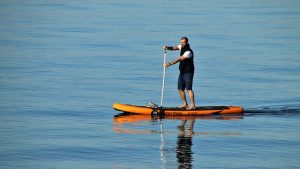Inflatable Paddle Boards (IPBs) offer a versatile, portable watercraft option for outdoor enthusiasts and fitness lovers. Their innovative design, made with durable yet lightweight materials like PVC or EVA foam, allows for easy transport, storage, and maneuverability—a game-changer for recreational users. IPBs cater to various skill levels, from beginners on calm waters to advanced paddlers in dynamic conditions. Key brands like Blue Water Paddle and Red Sea provide high-performance options with eco-friendly practices. When choosing, consider your skill level, intended usage, and personal preferences to ensure an optimal paddling experience.
“Discover the versatility and convenience of lightweight inflatable paddle boards (IPBs) – a game-changer in water sports. This comprehensive guide explores the unique benefits of IPBs, from their portable design to robust performance. We’ll delve into the materials used, storage solutions, ideal conditions, and top brands shaping this market. Learn how to choose the perfect IPB tailored to your needs, making every paddling adventure accessible.”
What is an Inflatable Paddle Board?
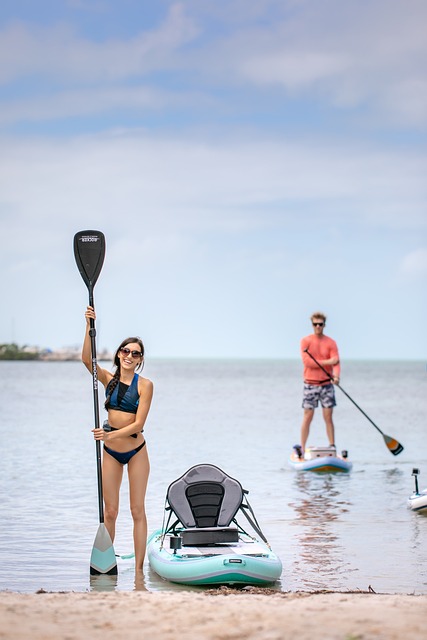
An Inflatable Paddle Board (IPB) is a versatile and lightweight watercraft that has gained immense popularity in recent years, especially among outdoor enthusiasts and fitness aficionados. Unlike traditional paddleboards, which are often made of rigid materials like foam or fiberglass, IPBs are designed to be inflated, making them highly portable and easy to store. This innovative feature allows users to easily transport their boards to various water bodies, from serene lakes to bustling beaches.
These boards come in a variety of sizes and shapes, tailored to different user needs and skill levels. The construction involves a robust yet lightweight material like PVC or synthetic rubber, which is sealed and inflated with an electric pump. Once deflated, they can be compactly folded or rolled up for convenient storage in a car trunk or even carried as hand luggage when traveling. With their versatility and ease of use, inflatable paddle boards offer a fun and accessible way to enjoy water sports, exercise, or simply relax on the water.
Advantages of Lightweight Design
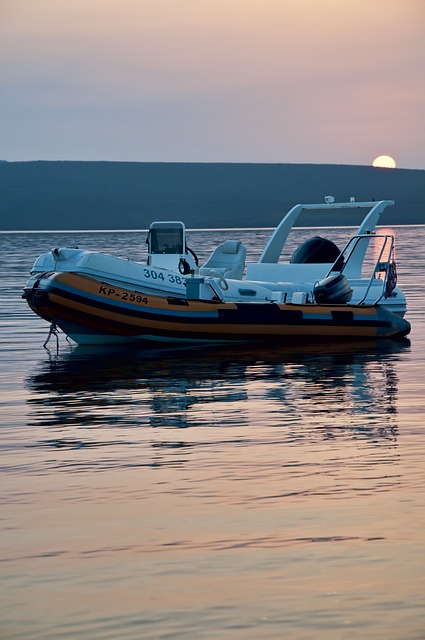
Lightweight designs offer numerous advantages, especially in products like inflatable paddle boards. One of the key benefits is increased portability and convenience. A lighter board is easier to carry, whether you’re transporting it to a lake for a day trip or stowing it away for storage. This makes it more accessible for outdoor enthusiasts who want to enjoy water activities without the hassle of lugging heavy equipment.
Additionally, lightweight materials contribute to enhanced maneuverability on the water. Inflatable paddle boards designed with this in mind can be easily steered and controlled, allowing users to navigate tight spaces or make sudden adjustments during their paddling adventures. This feature is particularly appealing for recreational users who prefer a more relaxed and agile experience on their board.
Materials Used for Portability
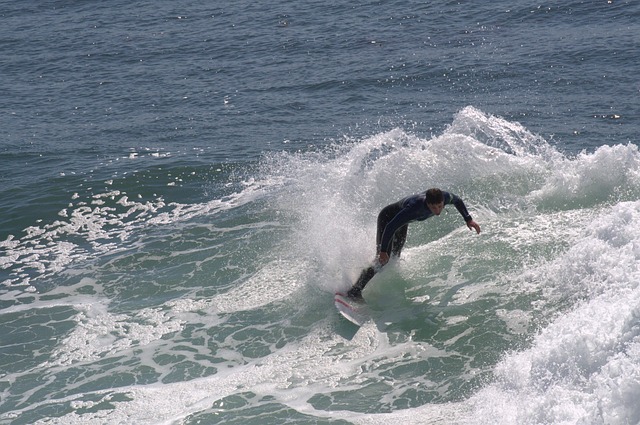
When it comes to portability, the materials used in manufacturing play a significant role in the overall weight and ease of transport. Inflatable paddle boards (IPBs) have revolutionized water sports due to their innovative design and lightweight construction. These boards are typically made from durable yet lightweight materials like PVC or EVA foam, ensuring they can be easily deflated and packed into compact sizes for travel.
The use of inflatable technology allows IPBs to be flexible and adaptable, offering a convenient solution for outdoor enthusiasts who enjoy water activities. Materials like PVC are known for their resilience and ability to withstand wear and tear, while EVA foam provides an additional layer of comfort and stability during paddling. This combination enables these boards to be lightweight, portable, and ready for action whenever and wherever the user desires.
How Does It Affect Performance?

The lightweight design of an inflatable paddle board (IPB) has a direct impact on its performance in the water. Lighter boards offer several advantages, such as improved maneuverability and easier transport. When paddling, a lighter IPB requires less effort to turn or change direction, enhancing agility and control. This is particularly beneficial for beginners or those looking to enjoy short bursts of paddling rather than long-distance touring.
However, while lightweight materials make inflating and deflating the board quicker, they might also compromise structural integrity. Lighter boards may not provide the same level of stability as their heavier counterparts, especially in choppy water conditions. As such, performance enthusiasts should consider balance and buoyancy when choosing a lightweight paddle board to ensure it meets their paddling needs effectively.
Easy Storage and Transportation Solutions

The lightweight design of inflatable paddle boards (IPBs) offers a significant advantage when it comes to storage and transportation. Unlike their solid counterparts, IPBs can be easily deflated and packed down to a fraction of their size, making them highly portable. This compactness allows users to store them conveniently in small spaces, such as closets or under beds, without sacrificing too much room. Moreover, transporting an IPB is a breeze; it can be tucked away in car trunks or even carried by hand, ensuring easy access for outdoor adventures and water-based activities.
The ease of storage and transportation solutions provided by inflatable paddle boards make them an attractive option for recreational enthusiasts and professionals alike. Whether you’re a seasoned paddler or just starting, the convenience factor offered by IPBs allows you to enjoy this sport in various locations, from calm lakes to dynamic rivers, without the hassle of bulky equipment.
Ideal Conditions for Using Inflatable Paddle Boards
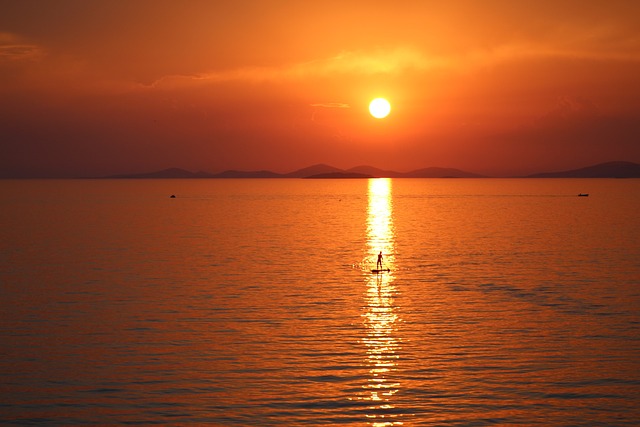
The ideal conditions for using an inflatable paddle board are calm, flat waters, such as lakes or protected coastal areas. These environments offer a smooth surface, free from waves and currents, allowing for a more enjoyable and controlled paddling experience. Inflatable paddle boards (IPBs) are versatile and can be used by various skill levels; however, beginners should opt for these conditions to master basic techniques without the challenges posed by choppy seas.
Additionally, IPBs perform best when the water temperature is pleasant, typically between 60-80°F (15-27°C), as cooler waters can make paddling more tiring. While some robust IPBs can handle lighter winds and moderate waves, optimal conditions ensure a seamless and relaxing experience, enabling users to fully appreciate the benefits of these portable watercraft.
Top Brands Leading the Market
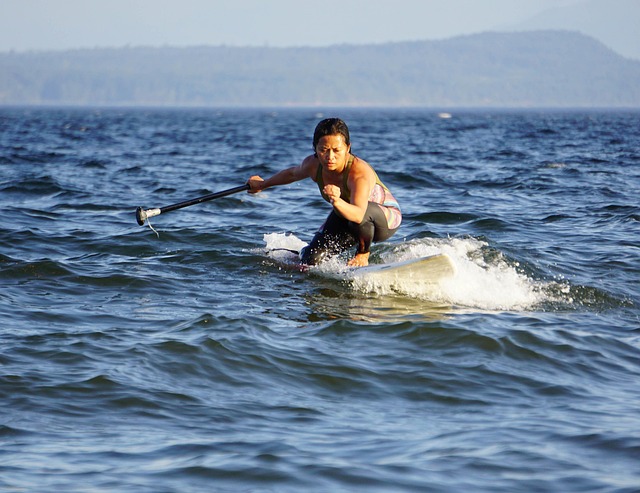
In the competitive world of outdoor gear, several brands stand out for their innovative and high-quality inflatable paddle boards (IPBs). Topping the list is Blue Water Paddle, renowned for crafting IPBs that are not only lightweight but also durable and fast. Their use of advanced materials ensures these boards perform just as well as their solid counterparts, making them a favorite among enthusiasts.
Another brand making waves is Red Sea. Known for their commitment to eco-friendly practices, Red Sea offers a range of IPBs designed with portability in mind. These boards are not only easy to pack and transport but also boast impressive maneuverability once on the water. Their focus on sustainability without compromising performance makes them a responsible choice for adventurers seeking both convenience and environmental consciousness.
Choosing the Right Inflatable Paddle Board for You

When selecting an inflatable paddle board (IPB), consider your skill level, intended usage, and personal preferences. For beginners, opt for a wider board offering stability and ease of paddling, often featuring a softer, more buoyant material. These boards are versatile and suitable for flat water conditions, allowing you to practice and build confidence.
Advanced paddlers may prefer narrower, performance-oriented IPBs designed for speed and agility in choppy waters or whitewater environments. These boards are typically stiffer, lighter, and made from durable materials like drop-stitch fabric, ensuring a faster glide through the water. Choose based on your paddling style and the type of adventures you plan to embark on, making sure it aligns with your fitness level and the board’s capabilities for an optimal experience.
